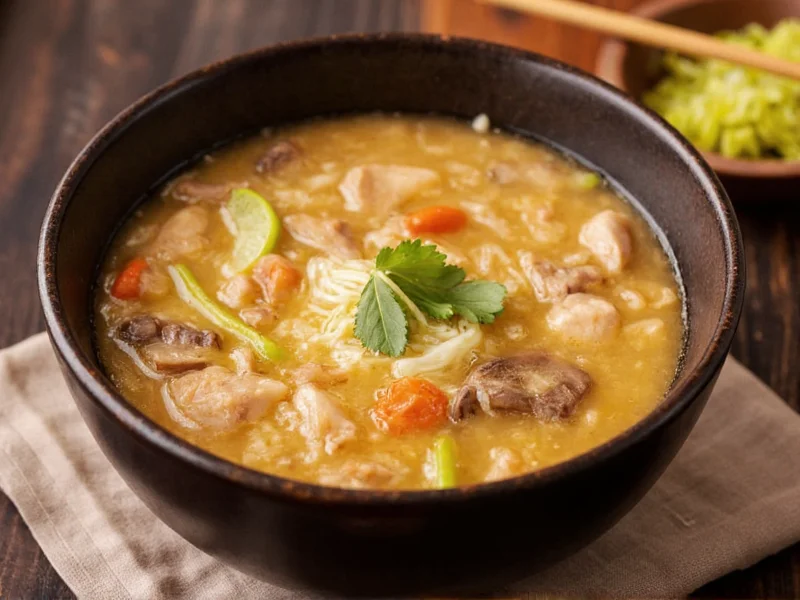Understanding the calorie content of miso soup is essential for those tracking nutritional intake or managing dietary goals. This Japanese staple offers a light yet flavorful option that fits well within various eating plans, from weight management to balanced nutrition approaches.
Factors That Affect Miso Soup Calorie Count
The calorie variation in miso soup primarily comes from three key elements: the miso paste concentration, additional ingredients, and serving size. Let's examine each factor that influences how many calories in a bowl of miso soup you're actually consuming.
Miso Paste Type and Quantity
Different miso varieties contain varying calorie densities:
- White miso (shiro miso): 25-30 calories per tablespoon
- Red miso (aka miso): 30-35 calories per tablespoon
- Barley miso (mugi miso): 35-40 calories per tablespoon
Most recipes use 1-2 tablespoons of miso paste per cup of dashi, directly impacting the final miso soup serving size calories.
Additional Ingredients
Common additions significantly affect the total calorie count:
| Ingredient | Amount | Calories Added |
|---|---|---|
| Silken tofu (½ cup) | 70g | +40 calories |
| Wakame seaweed (rehydrated) | 10g | +5 calories |
| Scallions (chopped) | 15g | +3 calories |
| Mushrooms (shiitake) | 30g | +8 calories |
Nutritional Profile of Traditional Miso Soup
Beyond calorie content, miso soup offers valuable nutrients. A standard 1-cup serving of basic miso soup (dashi + 1 tbsp miso paste) provides:
| Nutrient | Amount | % Daily Value |
|---|---|---|
| Calories | 40 | 2% |
| Protein | 2g | 4% |
| Carbohydrates | 6g | 2% |
| Dietary Fiber | 1g | 4% |
| Sodium | 600-800mg | 26-35% |
| Vitamin K | 15mcg | 13% |
Comparing Miso Soup to Other Common Soups
When evaluating miso soup nutrition facts against other options, miso soup generally ranks as one of the lowest-calorie soup choices:
- Miso soup: 35-70 calories per cup
- Vegetable soup: 70-100 calories per cup
- Tomato soup: 100-150 calories per cup
- Cream of mushroom: 200-250 calories per cup
Health Benefits Beyond Calorie Count
Miso soup's value extends beyond its modest calories in miso soup with tofu count. The fermented soybeans in miso paste provide probiotics that support gut health. Additionally, miso contains:
- Complete protein with all essential amino acids
- B vitamins including B12 (in some varieties)
- Minerals like manganese, zinc, and copper
- Antioxidants from the fermentation process
The sodium content (600-800mg per cup) represents the primary nutritional consideration for those monitoring salt intake. For a low calorie miso soup recipe with reduced sodium, look for reduced-sodium miso paste or dilute regular miso with additional dashi.
Creating Your Perfect Calorie-Controlled Miso Soup
Customizing miso soup to fit specific dietary needs is straightforward. For those specifically tracking how many calories miso soup contains in homemade versions:
- Use 1 tablespoon instead of 2 for a 25-30% calorie reduction
- Choose white miso for slightly fewer calories than red varieties
- Add vegetables like spinach or mushrooms for volume without significant calorie increase
- Limit tofu to ¼ cup if watching calories closely
- Measure your serving size—restaurant portions often contain 1.5-2 cups
Commercial Miso Soup Products Compared
Powdered and instant miso soup options vary considerably in calorie content. When comparing store-bought options:
- Traditional instant packets: 30-50 calories per serving
- Creamy or specialty varieties: 60-90 calories per serving
- Restaurant servings: 50-100 calories depending on size and ingredients
- Canned miso soup: 40-70 calories per cup
Always check labels for exact miso soup calories per serving as formulations differ significantly between brands. Some "miso-style" products contain thickeners and additional ingredients that increase calorie density.
Frequently Asked Questions
How many calories in miso soup without tofu?
A basic miso soup containing only dashi broth and miso paste (no tofu or other additions) contains approximately 35-50 calories per 1-cup serving. The exact count depends on the amount and type of miso paste used.
Is miso soup good for weight loss?
Yes, traditional miso soup can support weight loss efforts as it's low in calories (35-70 per cup) while providing satisfying umami flavor and some protein. Its high water content and modest fiber contribute to satiety. However, be mindful of restaurant portions which may be larger than standard servings.
Does miso soup have more calories than ramen?
Generally, yes—miso soup has significantly fewer calories than ramen. A standard miso soup contains 35-70 calories per cup, while even basic ramen starts at 180-250 calories per serving due to the wheat noodles. Miso soup makes a much lighter alternative to ramen when monitoring calorie intake.
How does miso soup compare to chicken soup nutritionally?
Miso soup typically has fewer calories than chicken soup (35-70 vs 60-100 per cup) but also less protein. Chicken soup provides more protein from the meat (6-10g vs 2-4g in miso soup), while miso soup offers probiotics from fermentation and different vitamin profiles. Both can be healthy choices depending on your nutritional goals.
Can I eat miso soup every day?
Yes, consuming miso soup daily is generally safe and potentially beneficial for most people. The fermentation provides probiotics that support gut health. The main consideration is sodium content (600-800mg per cup), so those with hypertension should monitor their intake or choose reduced-sodium varieties while enjoying the modest calorie count of 35-70 per serving.











 浙公网安备
33010002000092号
浙公网安备
33010002000092号 浙B2-20120091-4
浙B2-20120091-4